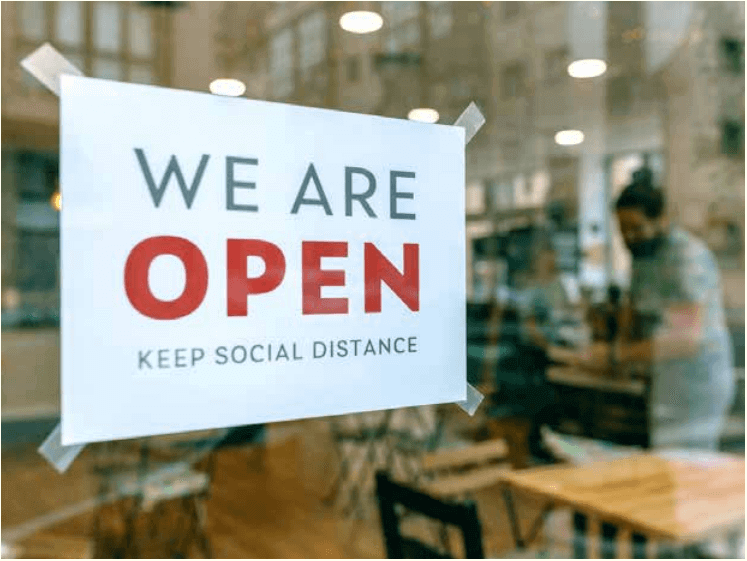Many businesses have adjusted to the pandemic by implementing work from home arrangements for their employees. This is often an incomplete or inadequate solution though. How has your work or business during the COVID-19 pandemic been affected?

The results can be less than ideal for the business, its employees and customers. Some businesses cannot even survive let alone thrive under these conditions and reopening at least to some extent is important for their
survival.
If your business is taking steps to reopen during COVID-19, you will need to adjust your operations in certain ways to prevent the spread of the virus. Your main goals will be to implement effective sanitation practices and
devise ways to accomplish physical distancing between people, both between employees and, if you are a retail operation, customers.
Different states have different regulations regarding how businesses, especially retail businesses, can conduct themselves during the pandemic. We refer to a couple of sources for detailed information by state at the end of this article. But here are some general, common sense approaches most businesses should take when they open their doors again during the pandemic.
Sanitation
- Encourage staff to follow hand washing protocol.
- Provide hand sanitizer in washrooms and throughout the premises.
- Clean busy areas more regularly.
- Clean and disinfect objects that are touched regularly. Retail operations should wash down surface areas where customers make frequent contact. For example: checkout screens and touchscreens should be washed every half hour.
- Set clear use and guidance for cleaning toilets.
- Provide hand drying facilities if you don’t have them already like paper towels or electric hand dryers.
In addition, retail operations should:
- If necessary, shorten hours, but take time to deep clean your premises daily or bring in outside contractors to do so.
- Remove sample offerings and install plexiglass shields and sneeze guards to separate cashiers from customers.
Social Distance
In businesses where employees are being allowed to come into the office again, most employees are probably choosing to stay home anyway (usually an option). That means those who go into the office should be able to practice social distancing more effectively. Still, you should reevaluate your office layout and determine ways to minimize contact between people.
Consider these suggestions:
- Put up signs to remind people of social distancing guidelines.
- Mark six-foot distances on the floor.
- Arrange one-way routing through the premises if possible, so that foot traffic always flows in the same direction, avoiding contact between people crossing paths.
- See visitors by appointment only if possible.
For activities that require people to work side by side:
- Determine whether the activity needs to continue for the business to operate.
- If so, keep the activity time as short as possible.
- Use screens or barriers to help protect people from each other.
- Stagger arrival and departure times.
- Reduce the number of people each person has contact with through fixed teams or partnering.
Retail businesses should reduce store occupancy maximums, which many states now mandate anyway. Restaurants, for example, may be limited to 25 to 40 percent of their usual capacity. Most grocery stores have reduced their occupancy to 50 percent or less.
Retailers should also continue to offer curbside pick-ups, encouraging customers to buy online and pick-up at the store or restaurant.
How the Pandemic Prompts Innovation
The pandemic has changed the way many businesses operate. Consider, for example, the use of contactless payments. “On March 27, Walmart began to provide options for no-contact payment, pickup and delivery, giving customers the option to use QR codes synched with the Walmart Pay app to purchase goods,” according to business consultancy Clarkston Consulting. “While already adopted by many retailers, contactless payment now is playing a bigger role as consumers are less likely to want to use cash or to touch the pin pad.”
Some retailers, such as Krogers, have adapted their in-store surveillance equipment to monitor how well customers are maintaining distance between each other. Loss prevention and shopper engagement technology company Indyme offers a system called SmartDome which understands when shoppers are too close to one another and alerts them with
audio reminders to maintain a six-foot separation.
Ideally everyone would work from home in isolation until the pandemic is over. But that’s neither practical nor socially acceptable for many people and in many situations. Although there are general guidelines for businesses that are reopening, there is no uniform set of standards. Each
state is different, so check out the requirement for your business in your state with these resources: State and Local Government COVID-19 Responses or retailers refer to Retail COVID-19 Safety and Security Tools.
Contact BPJ today to discuss your commercial insurance or options you have for your business insurance.
